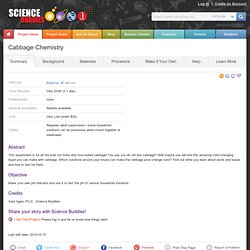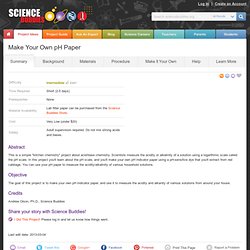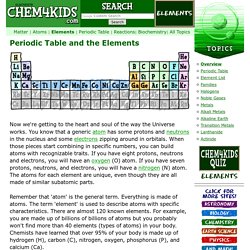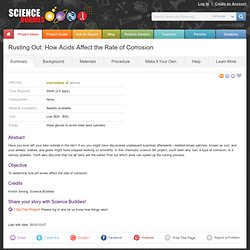

Home. Www.mhhe.com/physsci/chemistry/essentialchemistry/flash/ruther14.swf. Chemistry08. Chemistry08. Science 7 Chemistry Unit Outline. Cabbage Chemistry. Please ensure you have JavaScript enabled in your browser.

If you leave JavaScript disabled, you will only access a portion of the content we are providing. <a href="/science-fair-projects/javascript_help.php">Here's how. </a> Abstract This experiment is for all the kids out there who love boiled cabbage! Objective Make your own pH indicator and use it to test the pH of various household solutions. Credits Sara Agee, Ph.D., Science Buddies Share your story with Science Buddies! I Did This Project! Last edit date: 2013-10-15 Introduction. Color Changing Milk of Magnesia. Place about 100 mL of Milk of Magnesia in a 500 mL beaker and dilute with tap water until the beaker is about half full.

Add about 10 mL of Universal Indicator. (The Universal Indicator will provide the sharp color change you see in the video). Remember that Universal Indicator will turn red on the far acidic end of the scale and dark blue on the alkaline side. Use the magnetic stirrer to create a steady mix of the liquids. Chemistry Project Ideas. Log In|Create an Account All Results All Results Ask an Expert Blog Careers Project Ideas Resources Home Project Ideas Project Guide Ask An Expert Blog Careers Teachers Parents Students.

Make Your Own pH Paper. Abstract This is a simple "kitchen chemistry" project about acid/base chemistry.

Scientists measure the acidity or alkalinity of a solution using a logarithmic scale called the pH scale. In this project you'll learn about the pH scale, and you'll make your own pH indicator paper using a pH-sensitive dye that you'll extract from red cabbage. You can use your pH paper to measure the acidity/alkalinity of various household solutions. Objective The goal of this project is to make your own pH indicator paper, and use it to measure the acidity and alkanity of various solutions from around your house. Credits.
From Dull to Dazzling: Using Pennies to Test How pH Affects Copper Corrosion. Elements & Periodic Table. Now we're getting to the heart and soul of the way the Universe works.

You know that a generic atom has some protons and neutrons in the nucleus and some electrons zipping around in orbitals. When those pieces start combining in specific numbers, you can build atoms with recognizable traits. If you have eight protons, neutrons and electrons, you will have an oxygen (O) atom. If you have seven protons, neutrons, and electrons, you will have a nitrogen (N) atom. The atoms for each element are unique, even though they are all made of similar subatomic parts. Remember that 'atom' is the general term. As far as we know, there are a limited number of basic elements. With the tools you learn here, you can explore and understand the Universe. Since the launch of the site, we've been asked, "Why start with 18? " (1) Electrons fit nicely into three orbitals. Carbon Dioxide Can Make a Solution Acidic. Do a demonstration to show that adding CO2 gas to water can make the water become acidic.

Materials for the Demonstration Universal indicator solution Water 2 clear plastic cups Straw Teacher Preparation Make indicator solution for student groups Make a dilute universal indicator solution for this demonstration and for each student group by combining 625 mL water with 25 mL universal indicator solution. Pour at least 80 mL of this dilute universal indicator solution into a clean plastic cup for each student group. Note: Your local tap water is likely fine for the demonstration and activities in this lesson. If the indicator solution you make is not green, this means that your water is either acidic or basic. If this happens, use distilled water, which is available in supermarkets and pharmacies. Remove as much air as possible and drop the Alka-Seltzer tablet through the small opening. Pace of Ocean Acidification Has No Parallel in 300 Million Years, Paper Says.
Rusting Out: How Acids Affect the Rate of Corrosion. Please ensure you have JavaScript enabled in your browser.

If you leave JavaScript disabled, you will only access a portion of the content we are providing. <a href="/science-fair-projects/javascript_help.php">Here's how. </a> Abstract Have you ever left your bike outside in the rain? Objective To determine how pH levels affect the rate of corrosion. Credits Kristin Strong, Science Buddies Share your story with Science Buddies! I Did This Project! Last edit date: 2012-12-07 Introduction Have you ever been told to bring your bike in out of the rain? Rust changes steel into a different material, one that is weaker than the original steel. Rusting is an example of a process called corrosion.
When iron and oxygen combine to make iron oxide (rust), heat is given off, which means the reaction is exothermic (exo means "out" and therm means "heat," so heat is sent out when the reaction occurs). Terms and Concepts Questions With what element does iron like to combine? Bibliography. Rocketology: Baking Soda + Vinegar = Lift Off!